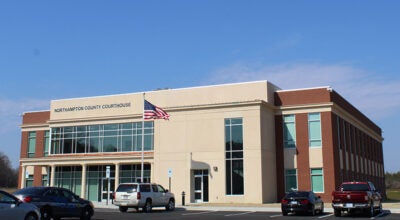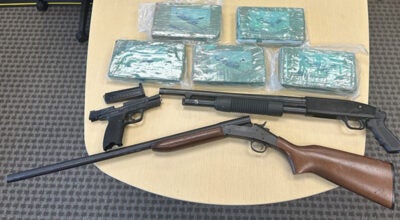Truth, Lies and Power – Part 2
Published 12:35 pm Tuesday, September 11, 2018
(Editor’s Note: Today, the Roanoke-Chowan News-Herald publishes the second of a three-part series about a farmer in the Boykins, VA area with ties to Northampton County who is currently locked in a legal battle with agricultural officials at the federal level. The series is published with the permission of Farm Journal.)
By CHRIS BENNETT
Farm Journal
“In May (2016) I was on top of the world with two solid crops and suddenly things went crazy when NRCS (National Resources Conservation Service) made a new wetlands determination,” said Hood. “They sent out an official named Greg Hammer and he says my land is a wetland and what I’ve been doing is illegal. I’m a simple man and was suddenly dealing with officials that were arrogant and smug beyond belief. There was no way to reason with them. They were checking off boxes, coming up with whatever data they wanted, and all I could do was watch. You don’t know what helpless is until you’ve experienced this type of control.”
(Citing pending litigation, Hammer, a resource soil scientist with Virginia NRCS, declined comment related to the Hood case.)
Sammy Drake, 71, grows peanuts, corn, cotton and soybeans in Southampton County. He was on-site during a June 29, 2017, NRCS personnel visit to Hood’s land.
“It is hard to describe the condescending attitude from the NRCS people I witnessed,” Drake said. “Charles Hood is the single most honest man I know and you won’t find anyone who has helped more farmers. This is how NRCS treats him? Only unaccountable people would dare to behave this way.”
Labeled a wetlands violator, NRCS wanted Hood to return approximately $35,000 in EQIP and other program payments. Hood took his protests from the county committee to the state committee and then to the National Appeals Division. He obtained the services of attorney Gary Baise, OFW Law. Baise, wielding a lifetime of wetlands-swampbuster legal experience, was laser-focused on addressing the facts. Since the inception of the Clean Water Act in 1973, Baise has seen innumerable wetlands-related cases filter through the U.S. court system, but he contends the Hood case is uniquely filled with “mendacity and duplicity” from agency officials.
Pulled directly from Baise’s NAD brief (Case No. 2017E000755), submitted March 5, 2017: T25864 [Hood’s land] has been a tree farm for decades and a soybean field for seven years. Hydric soil does exist on the property but there is no evidence, only conclusions, in the record of hydrology or prevalence of hydrophytic vegetation on the property … just conclusions by a NRCS employee and his work has never been double checked by anyone else in NRCS.
Baise contends NRCS’ actions related to Hood’s land during the 10-plus years following 2006 are entirely incongruent with the agency’s enforcement action in 2016.
“NRCS knew it was clear-cut timber. They put him in the EQIP program and paid him,” Baise explains. “Now they want the cash back and pretend he was making all these violations? Are you kidding? They lied and they are out of control. This case is a stunner and they didn’t want a judge or the public to know any of this. Their personnel met with Hood on countless occasions and even had one official meet with him over 60 times.”
Pulled from Baise’s March 5, 2017,NAD brief: Testimony by Ms. Stokes [Yamika Bennett] indicates that over the next 11 years, possibly 60 meetings between Appellant and Ms. Stokes occurred to discuss activities which could be taken on the land designated as converted wetland.
“Go across the nation and you can find some wonderful people in NRCS. But in this case, NRCS agents were caught dead-wrong. They won’t admit a thing, but they’ll sure double-down, even if it means running over a small farmer with 30 acres and ruining him,” Baise adds.
Significantly, in 2016-2017 paperwork filled out regarding Hood’s alleged violations, NRCS never mentioned the site was atypical and had been clear-cut. Additionally, NRCS didn’t admit the site had ditches on all sides of the property, according to Baise.
Fired by Accident?
Hood’s case (Charles Hood, Jr. vs Farm Service Agency) was assigned to Administrative Judge Christopher Hanifin, but prior to the NAD date, FSA terminated Hood’s employment.
“When the judge found out they fired me, the government literally told him it was a clerical error,” Hood said. “I’m not kidding. Inside the courtroom, they seriously claimed that after 40 years as an FSA employee, I had been fired by accident. They actually tried to slide that past the judge in court. That tells you what you need to know about my case and their arrogance.”
“They fired Hood right before the trial and the judge was outraged, so they gave him his job back. It was unreal,” Baise echoes.
Hanifin was tasked with ruling on the preponderance of evidence; a judgement based on facts. On its face, the case was simple: Did NRCS do its job properly on the Hood property?
The government’s position unraveled on the witness stand, according to Baise, who navigated the minutia of wetlands complication. “They hadn’t followed procedure. They just said it was a wetland and expected their word would rule the day. It was disgraceful and Judge Hanifin saw through it all. We caught them in repeated lies and it didn’t go over well in court.”
Again, pulled directly from Baise’ brief: On September 18, 2006, NRCS employees Yamika Stokes (Bennett) and Greg Hammer allegedly completed a wetland determination on T25864. There are no exhibits, calculations, or records on data forms that record that NRCS employees followed the procedures as required by the NFSAM or the COE 1987.
Additionally, from Baise’s brief: NRCS and Mr. Hammer used discretion and acted arbitrarily, capriciously and recklessly in determining T25864 is a wetland. No evidence exists in the record showing Mr. Hammer’s work was ever checked. Jerry Quesenberry, an expert wetlands delineator with 17 years experience with NRCS, testified that Mr. Hammer was wrong in his conclusions regarding T25864.
Quesenberry’s credibility held strong on the stand.
“I knew it wasn’t a wetland and explained why to the judge,” he said. “I backed up what I said with data and on-site testimony. He was getting evasive BS from the other side, sort of like evasion tactics.”
In the footnotes of Hanifin’s eventual ruling, the judge wrote remarkably tell-tale praise related to Quesenberry’s testimony: “I base my credibility finding on Appellant’s [Hood] retired NRCS soil expert’s [Quesenberry] testimony, professional and earnest demeanor, lack of motive to achieve a result, unwavering conviction and lack of hesitancy when answering questions, and in detailed statements throughout the evidentiary record. Finally, I find credible the expert’s capacity to recollect and communicate honestly events, including not stating conclusions unless the soil expert was sure of the answer and its veracity, especially when otherwise doing so would be self-serving or push the bounds of believability.”
Next in the series: Bureaucratic vendetta?
Chris Bennett works as the Technology and Issues Editor with Farm Journal.



